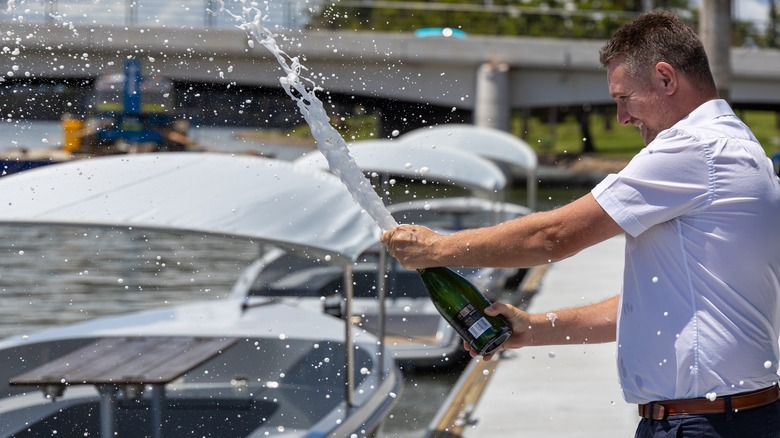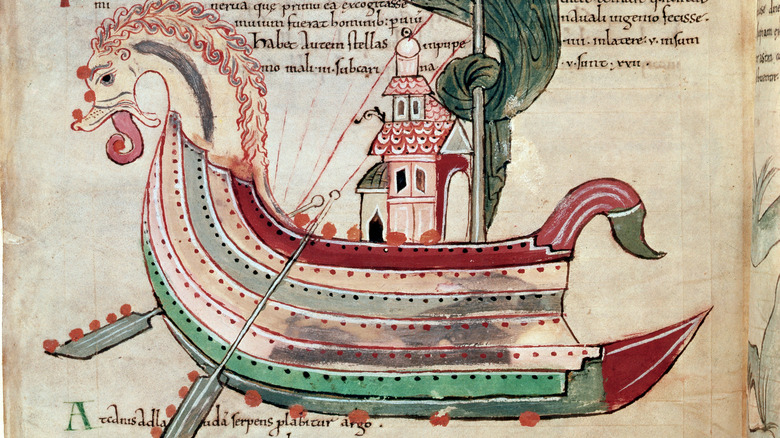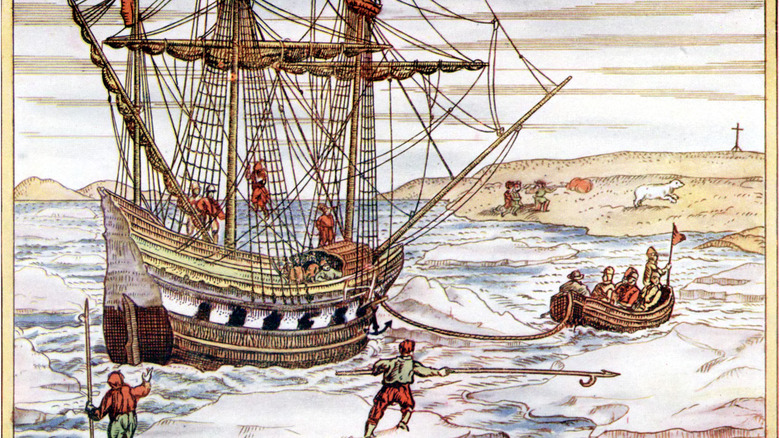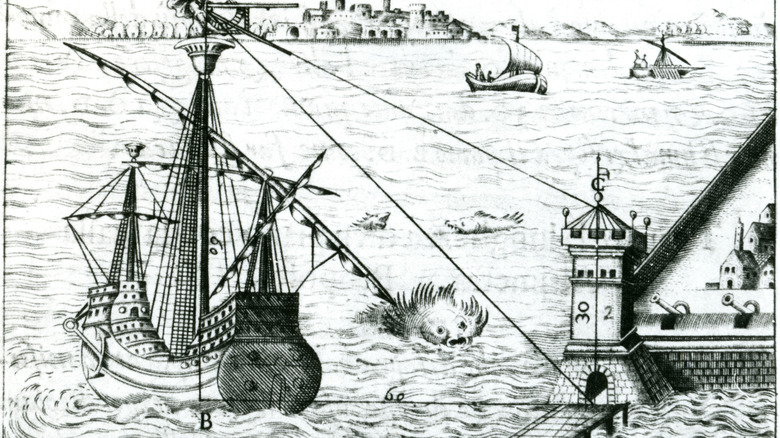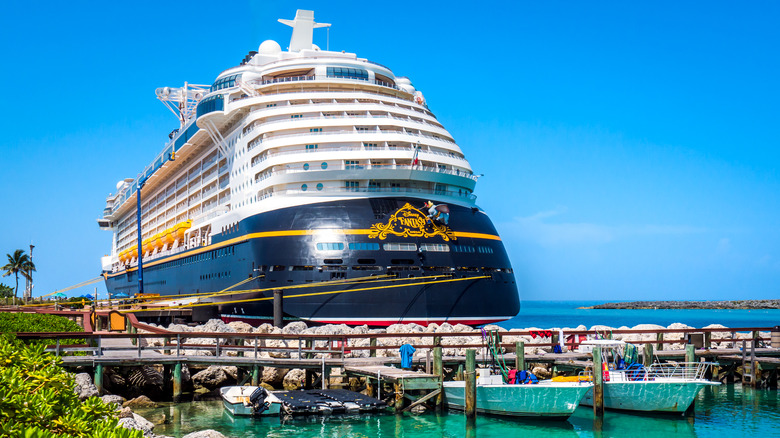The Origin Of Using Champagne To Christen Ships
Humans have been sailing the oceans for millennia, likely tens of thousands of years before we started writing things down, according to Future Learn. Ancient seafaring led to changes in population and expanding human settlement, the mixing of various cultures — which in itself helped develop written language — and of course, it was and is an integral part of the economic fabric of any society and the world at large.
Of course, when you get into a sailing vessel, you are taking several risks, the biggest of which is a painful death via drowning. Or your ship could run aground, or be besieged by brigands, or sunk by a rival navy. As such, sailors over the millennia became a rather superstitious lot; indeed, even the Bible records an incident in which a ship is bedeviled by a storm, and the sailors appeal to superstition to try to save their lives.
One such superstition still largely employed by Western sailors (or, more likely, the corporation that owns the ship) involves christening a new ship (or boat) by breaking a bottle of champagne over its hull.
Ancient ship-launching rituals
We've used the word "christen" here to describe ceremonially naming a ship, but let's be clear: The tradition of invoking the blessings of a deity to protect the ship and allow it to prosper predates Christianity by millennia. For example, the U.S. Navy provides a blessing — dating from the third millennium B.C. — invoked by an ancient Babylonian seafarer unto his ship. "Openings to the water I stopped; I searched for cracks and the wanting parts I fixed; Three sari of bitumen I poured over the outside; To the gods I caused oxen to be sacrificed," the ancient text reads.
The same naval document reveals that other ancient cultures also appealed to their gods when launching a ship. The ancient Greeks invoked the favor of their sea god, Poseidon, while wearing olive wreaths on their heads. The ancient Romans would invoke their sea god, Neptune, and the Egyptians would invoke theirs. All three traditions would drink water to honor the gods and, perhaps ironically, pour water on the vessel, according to the Navy.
Christianity complicates things
When Christianity started marching through Europe beginning in the first century, it wouldn't do to invoke ancient, non-Christian deities when invoking the "new" god would work just as well. Further still, there's the matter that the word "Christianity" gave us the word "christen." As Dictionary.com explains, the word "christen" actually means to accept someone into Christianity and/or to give them a name at their baptism.
Of course, a ship is not a person, and you can't baptize it — or can you? As Mental Floss notes, for centuries, Christian sailors — at least in Europe — gave it their best shot. For example, during the Middle Ages, in England, priests would board the ship, pray, and sprinkle holy water on the bow and deck. Chaplain Henry Teonge of Britain's Royal Navy provides an account of just such a ceremony in 1675 (via the U.S. Navy): "Two fryers and an attendent went into the vessel, and kneeling down prayed halfe an houre, and layd their hands on every mast, and other places of the vessel, and sprinkled her all over with holy water. Then they came out and hoysted a pendent to signify she was a man of war; then at once thrust her into the water."
The Protestant Reformation throws a wet blanket on everything
The Protestant Reformation, at least in England, marks the end of tying the naming of a new ship to any sort of religious invocation, according to Mental Floss. It also marks the end of using the word "christen" to literally tie the ceremony to Christianity and instead marks the beginning of the use of the word in its secular sense: to bestow a name on something.
The new method of christening a ship in those days consisted largely of having a royal (or other important person) pay a visit to the vessel, and he and the crew would then drink from a ceremonial cup, announce the ship's name, then pour the rest onto the ship. He would then toss the cup overboard to be caught by a lucky bystander or sink to the bottom of the sea. The process later evolved to catching the goblets in a net for reuse and, later still, simply breaking a bottle of wine across the bow.
Why champagne
Over the centuries, various seamen used other liquids to christen their ships (via Mental Floss). The USS Constitution, for example, was christened in 1797 by the captain breaking a bottle of Madeira over the bow, while the USS Princeton and other ships were christened with whiskey. Elsewhere, some were christened with grape juice or spring water. Of course, there was the dreaded period of prohibition in the U.S., and the effects of that legislation were felt even when it came to christening ships. During this period, ships were again christened with water, grape juice, or even apple cider.
When prohibition ended, champagne became the beverage of choice for a good reason. You may have noticed that big announcements or big accomplishments — a pregnancy, a marriage, a team winning a championship — are celebrated by spraying champagne. That's because a bottle of champagne is basically a bomb: The liquid inside is pressurized to a degree that, under the right conditions (such as when the bottle is struck against the bow of a ship), it explodes, creating a satisfying burst of liquid and glass.
Are ships still christened with champagne?
The ceremonial naming of sailing vessels has been a thing for thousands of years, but in the days of modern navigation methods and scientific reason (as opposed to superstition and hope), are ships still christened?
Some are, yes. For example, all of the Disney cruise ships (one of which is depicted above) have been christened by the ceremonial shattering of a bottle of champagne across the bow, often accompanied by pop music performances, says Cruisedig. Carnival has done the same thing on at least one occasion, although in the case of the christening of Carnival Radiance, ceremonial seaman Shaquille O'Neal christened her by pouring water over her bell (via Travel Pulse).
The U.S. Navy still christens at least some of its ships with champagne, such as when USNS Harvey Milk — named for the slain LGBTQ rights leader — was christened, according to KQED. The process also still appears to apply to cargo ships. For example, in 2018, the cargo ship Daniel K. Inouye (at the time the largest cargo ship ever built in the U.S.) was christened in a ceremony (per The Maritime Executive).
When it comes to private vessels, such as the sailboat you just bought, it's a matter of filling out legal paperwork, although you're still free to ceremonially christen the vessel in whatever way seems fitting to you (via Gone Outdoors).
